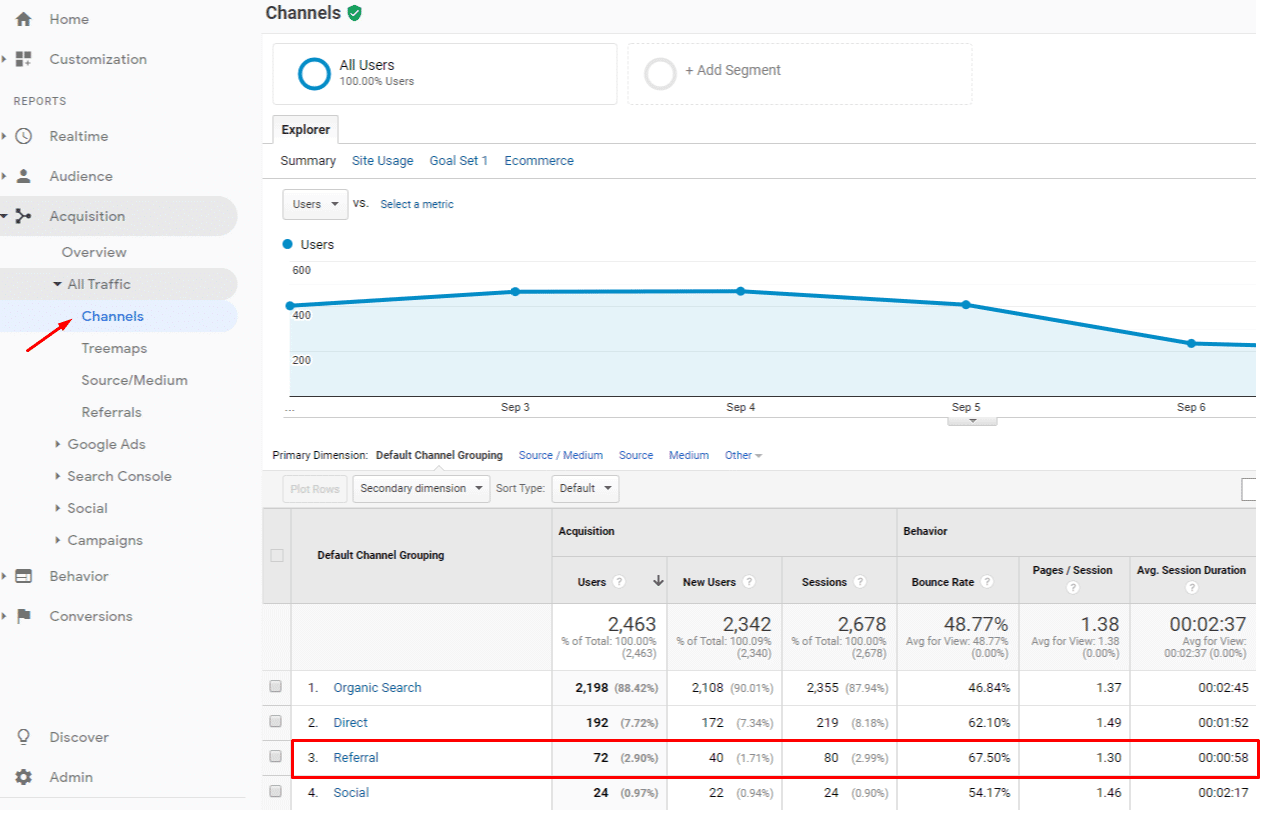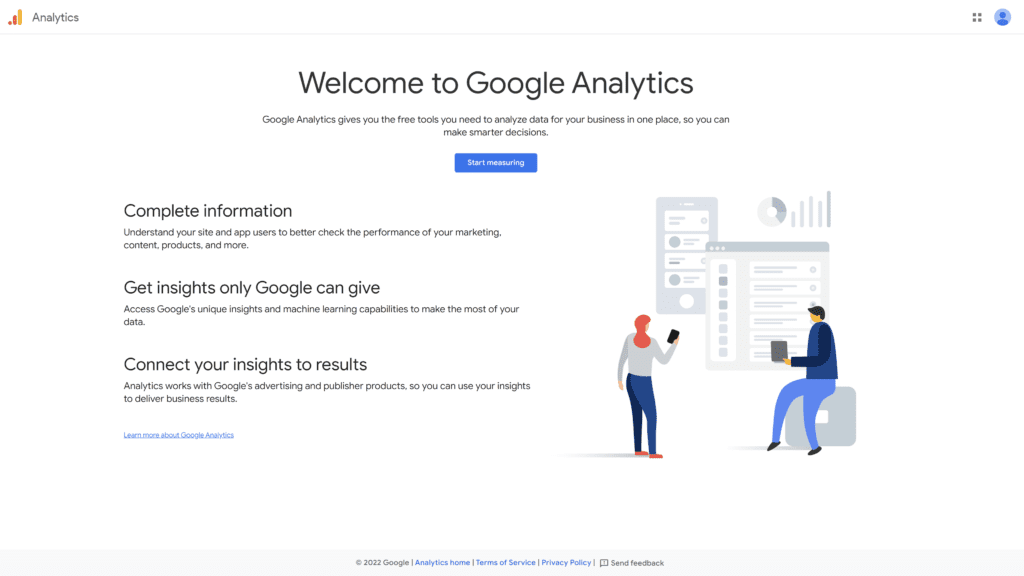Your blog traffic is the key indicator of its overall performance.
And if you do not truly understand how blog traffic works, then you need to ask why you’re even blogging at all!
In fact, there’s more to blog traffic than the number of visitors your blog.
You must understand where the traffic is coming from, the quality of traffic your blog receives, and more!
Knowing all these things should steer you in the right direction as far of improving your blog’s process is concerned.
To help you make better blogging decisions, you must use one of the most powerful tools for analyzing traffic: Google Analytics.
If you’re not using it yet and want to learn more, then read on!
How Can I Check My Blog Traffic?
Your blog traffic is the metric to weigh your blog performance.
However, and as mentioned above, traffic is just an overall term to call all the users who visit your blog.
A user coming in from social media is not the same as the one coming in from a guest post.
Why?
For example, if you haven’t set up any social media presence yet, then you’ll question the traffic you are getting from social media.
It could be because people are starting to share your blogs now, which can give you a clue on what people like to read.
Here are some traffic metrics to track and analyze:
- Source – Describes where your traffic is coming from.
Use this information to identify sources you need to focus or improve on - Bounce rate – The percentage of a single session where your visitor has no interaction with your page.
It tells you how frequently users leave your blog without visiting any other pages - Average Time on page – The average length of stay of your visitors on your page.
Aim to make your visitors stay longer by writing better content and optimizing your page speed
Knowing and understanding all of these using Google Analytics helps you fix any leaking holes that you didn’t know existed before.
Your content marketing strategies, better blog post, and the development and design of your blog are all going to benefit if you can analyze what you are currently doing.
Why Is Tracking Important?
Getting to know Google Analytics is important for any blogger, regardless of blogging experience or niche.
Utilizing Google Analytics reporting tools can give you and your team a better understanding of what is working for your blog, what readers are interested and engaging in, and where readers are finding you.
When you know what areas you’re doing well in and what areas need improvement, you can change your blogging strategy to reach more and more readers.
Before you can begin doing any analytics tracking, you’ll need to set up your Google Analytics page for your blog if you haven’t already.
How Do I Install Google Analytics On My blog?
Installing Google Analytics is easy and doesn’t require any plugins.
Here’s a quick guide on how to install it regardless of what CMS you use.
Create a Google account and make sure that you’re logged in to it before you head to go to the next step.
Go and sign up a Google Analytics account for free and fill out all the needed information such as your website URL and country.
From there, Google will automatically create a property for you.
You will find a tracking code similar to this below:

This the Global Site Tag, a unique tracking code that you need to paste on the header or footer file of your website.
Once you have it all set up and installed properly, you can wait for a few days and review all the traffic your blog receives.
Note that it will take approximately 24 hours for GA to start collecting data from your site.
Once GA has collected enough data for you to analyze, you can click on any metric buttons they have available.
Here’s a screenshot that shows the acquisition channels which includes source, number of users, bounce rate, and average time on site for seven days.

As you can see, the referral channel is lagging in all the above metrics compared to other channels.
When someone clicks on a link to your blog, GA marks it as referral traffic.
In the data above, this traffic source shows a higher bounce rate and a much lower average session duration.
What this data tells is there could be better improvements on what kind of websites the link building strategy is doing or focused on.
Additionally, the average session duration on all channels can also be improved by working on the quality of the content and fixes for a few design properties.
But, you don’t always have to look at the negative side of things.
This GA screenshot shows that almost 90% of the users are from organic search, meaning, the SEO efforts are going quite well and just needs a few tweaks for improvements.
These are just some of the details GA will show you to help you understand what your blog’s traffic is about.
However, web analytics only uncovers your blog’s traffic information.
Getting Familiar With Google Analytics
Setting up your page is easy and the Google Analytics page will walk you through the necessary steps.
Once you’re in Google Analytics, you’ll be met with a dashboard full of numbers, charts, graphics and more that explains who is looking at your profile, where those people are coming from, and how long they engage with your blog.
All the information you need is there, but you need to understand where to find it, which numbers are most important to developing a strong strategy for getting new followers, and which charts you should be tracking.
Your goals will ultimately determine which areas you will use, but for bloggers, the most important sections are usually the same.
Areas to Track
Before you can begin a strategy to get more blog followers, you’ll need to figure out what you’re doing that is working and what you’re doing that isn’t working.
This can be done by looking at a few key areas of your Google Analytics report.
But the very first step you need to take before jumping in to Google Analytics is to determine what your goals are.
Growing readership looks different to every blogger and will largely depend on where your blog is currently and where you would like it to go.
If you are just starting out, your goals will look much different than someone who has been blogging for years.
Your goals will determine your area of focus.
Most Popular Pages
One of the many beneficial measurement tracking components of Google Analytics is page views and the time spent on each page.
Seeing which posts are visited frequently and commonly read all the way through can give you an idea of the kinds of posts your audience enjoys.
To find which posts are your most popular, begin on the “Pages” section of Google Analytics.
Along the sidebar, find “Behavior,” then select the subcategory “Site Content.” Finally, select the “All Pages” option.
This should pull up a grid detailing your most popular pages, including the number of visits to that page as well as the time spent on that page.
There are a few things to consider in this area.
If you post a variety of lengths in regards to your blog, the time spent on each page may be skewed.
Longer posts obviously take longer time to read, so you shouldn’t confuse long page view times with popularity.
You also should consider that certain pages, like a landing page, will probably have more views than other posts, but people usually leave these pages relatively quickly.
Use both the time spent on the page and the number of views on the page in relation to each other to determine which posts have received the best response.
Reader Acquisition
Another thing you will want to consider before starting your strategy is where your readers are coming from.
This information will be crucial when understanding which social media platforms to target in your strategy to get new followers.
To find a detailed account of your readers, you’ll want to go the “Acquisition” section of the sidebar.
Then select “Social.”
This will give you an overview of where your social media pages are doing their job of turning posts into views to the website.
It will also give you an idea of which social media pages your readers are engaging with and what pages might need an updated strategy.
Conclusion
Blogging is a great platform to share your ideas with an audience.
However, to truly be effective, you need to understand how your blog is performing under certain factors.
Understanding these allows you to create better content and promote it in the right places to generate even more traffic.
As you can see, Google Analytics is able to take the guessing game out of content creation and promotion, given you a clear indication of what content is resonating best with your followers and what social media pages are getting the most traffic.
When you understand what is working for you and your blog, you can create a better strategy for targeting and attacking new followers.
To be successful in Google Analytics isn’t difficult.
You just need to understand what your blogging goals are and what areas on Google Analytics to track.
For starters, popular pages and acquisition are the most important.
As you continue to understand your audience and readership, this information can be applied in a number of different ways to develop a more targeted promotional strategy.







